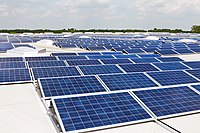
Photo from wikipedia
Abstract Photovoltaic arrays are mainly installed to generate maximum power and serve the load demand. However, the arrays are susceptible to various unpredictable scenarios such as partial shading and electrical… Click to show full abstract
Abstract Photovoltaic arrays are mainly installed to generate maximum power and serve the load demand. However, the arrays are susceptible to various unpredictable scenarios such as partial shading and electrical faults that reduce the overall performance and result in serious power loss, hotspot formation, and severe damage to the modules. So, partial shading and fault detection algorithms are considered to be an important constituent to avoid unwanted power loss and system failures. Most of the algorithms use the voltage and current variation approach as detecting indicators for shading and faults. However, the array voltage and current can also vary due to certain other factors such as module temperature difference that result in reliability reduction due to false detection. In this paper, the sensitivity of various widely used array topologies to partial shading and electrical faults have been studied using various electrical parametric indicators. The variability of these indicators to shading and faults has been studied for determining the most relevant indicators that can be used for shade and faults detection in all array topologies. Also, the topologies have been studied using the characteristics curves, power generation, and mismatch losses to determine the most fault-tolerant topologies. The entire study has been performed in the MATLAB/Simulink environment and validated using experimental analysis. It has been found that the indicators largely varies to the shading/faults in the arrays and differs for different topologies and can be used to detect/predict faults. Also, it has been found that during minimum (10%) and maximum (90%) system shading, the parallel topology generated higher power nearly equal to 88.95% and 19.48% of the unshaded scenario respectively. However, during 90% system fault, all the topologies generated nearly equal power i.e. 11.27% of the no-fault scenario.
Journal Title: Energy Conversion and Management
Year Published: 2020
Link to full text (if available)
Share on Social Media: Sign Up to like & get
recommendations!